
The order Lamiales are an order in the asterid group of dicotyledonous flowering plants. It includes about 23,810 species, 1,059 genera, and is divided into about 25 families. These families include Acanthaceae, Bignoniaceae, Byblidaceae, Calceolariaceae, Carlemanniaceae, Gesneriaceae, Lamiaceae, Lentibulariaceae, Linderniaceae, Martyniaceae, Mazaceae, Oleaceae, Orobanchaceae, Paulowniaceae, Pedaliaceae, Peltantheraceae, Phrymaceae, Plantaginaceae, Plocospermataceae, Schlegeliaceae, Scrophulariaceae, Stilbaceae, Tetrachondraceae, Thomandersiaceae, Verbenaceae.

Acanthaceae is a family of dicotyledonous flowering plants containing almost 250 genera and about 2500 species. Most are tropical herbs, shrubs, or twining vines; some are epiphytes. Only a few species are distributed in temperate regions. The four main centres of distribution are Indonesia and Malaysia, Africa, Brazil, and Central America. Representatives of the family can be found in nearly every habitat, including dense or open forests, scrublands, wet fields and valleys, sea coast and marine areas, swamps, and mangrove forests.
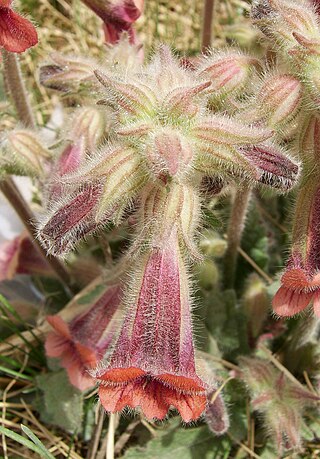
Rehmannia is a genus of seven species of flowering plants in the order Lamiales and family Orobanchaceae, endemic to China. It has been placed as the only member of the monotypic tribe Rehmannieae, but molecular phylogenetic studies suggest that it forms a clade with Triaenophora. Contrary to the immense majority of the taxa of Orobanchaceae, Rehmannia is not parasitic.
Monocarpic plants are those that flower and set seeds only once, and then die.

Avicennia is a genus of flowering plants currently placed in the bear's breeches family, Acanthaceae. It contains mangrove trees, which occur in the intertidal zones of estuarine areas and are characterized by its "pencil roots", which are aerial roots. They are also commonly known as api api, which in the Malay language means "fires", a reference to the fact that fireflies often congregate on these trees. Species of Avicennia occur worldwide south of the Tropic of Cancer.

Acanthus is a genus of about 30 species of flowering plants in the family Acanthaceae, native to tropical and warm temperate regions, with the highest species diversity in the Mediterranean Basin and Asia. This flowering plant is nectar producing and is susceptible to predation by butterflies, such as Anartia fatima, and other nectar feeding organisms. Common names include Acanthus and bear's breeches. The generic name derives from the Greek term ἄκανθος (akanthos) for Acanthus mollis, a plant that was commonly imitated in Corinthian capitals.
Plietesials are plants that grow for a number of years, flower gregariously (synchronously), set seed and then die. The length of the cycle can vary between 8 and 16 years. For example, the neelakurinji plant flowers every 12 years and bloomed as expected in 2006 and 2018 in the Munnar region of Kerala, India.

Ernest Edward Galpin (1858–1941), was a botanist and banker born in the Cape Colony. He left some 16,000 sheets to the National Herbarium in Pretoria and was dubbed "the Prince of Collectors" by General Smuts. Galpin discovered half a dozen genera and many hundreds of new species. Numerous species are named after him such as Acacia galpinii, Bauhinia galpinii, Cyrtanthus galpinii, Kleinia galpinii, Kniphofia galpinii, Streptocarpus galpinii and Watsonia galpinii. He is commemorated in the genus Galpinia N.E.Br. as is his farm in the genus Mosdenia Stent.
Thomandersia is the sole genus in the Thomandersiaceae, an African family of flowering plants. Thomandersia is a genus of shrubs and small trees, with six species native to Central and West Africa.

Anisotes is a genus of Afrotropical plants in the family Acanthaceae. The genus is morphologically similar to Metarungia, from which it differs mainly in the dehiscence of the fruit capsule, and the nature of the placenta. Placentas remain attached to the inner surface of fruit capsules in Anisotes.
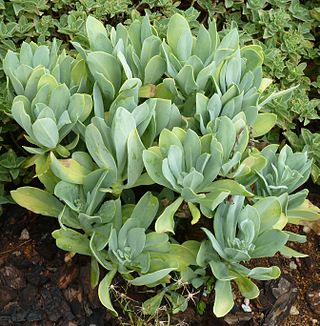
Kleinia galpinii is a species of flowering plant in the family Asteraceae. It is native to Zimbabwe, Eswatini, and South Africa's KwaZulu-Natal and Northern Provinces. The species name commemorates E. E. Galpin. It has gained the Royal Horticultural Society's Award of Garden Merit as a warm temperate greenhouse ornamental.

Anisotes pubinervius is an Afrotropical plant species in the acanthus family, which is native to forest understorey in the Afromontane archipelago. It is widespread in eastern Africa, with isolated populations in southern Africa and Nigeria. The species is named for the fine down that covers the main leaf veins (-nervia).

Schaueria is a genus of flowering plants in the family Acanthaceae. They are endemic to Brazil, from Bahia to Rio Grande do Sul. They are characterized by small elongated white or yellow flowers and narrow to thread-like green or yellow bracts. They are found mainly in rain forests, semi-deciduous mountain forests, and restingas. They are pollinated by bees and hummingbirds.
Aphanosperma is genus of flowering plant in the family Acanthaceae containing a single species, Aphanosperma sinaloensis. It is endemic to Mexico. The species is self-compatible and autogamous.

Haplanthodes is a genus of flowering plants in the family Acanthaceae. It includes four species endemic to India.
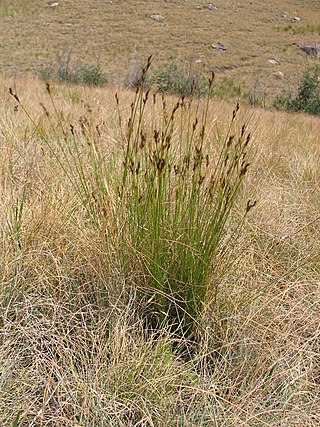
Schoenus galpinii is a species of sedge endemic to eastern southern Africa.
Leptorhabdos is a monotypic genus of flowering plants, initially classified in Scrophulariaceae, and now within the broomrape family Orobanchaceae. It contains a single species, Leptorhabdos parviflora.
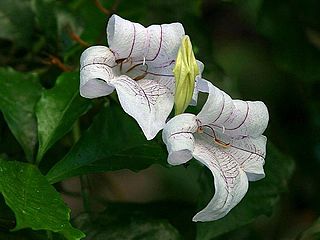
Mackaya is a genus of flowering plants in the family Acanthaceae, disjunctly distributed in South Africa and the eastern Himalayas, Southeast Asia, and China. It is sister to Asystasia.

Faurea galpinii is a small tree that grows to 10 m (20 ft.) tall, but its trunks will vary depending on growing conditions. The leaves of F. galpinii are alternately lanceolate with wavy margins. When growing in the forest, the bark appears grey with smooth, concentric rings, although it can appear rough and dark under exposed conditions, and the variety Faurea gal pinii varies in size from 1 m to 2 m.
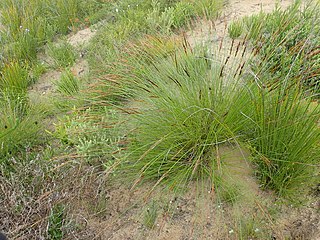
Schoenus graciliculmis is a species of sedge endemic to regions of the southern Eastern Cape Province and nearby regions of the Western Cape Province of South Africa.













